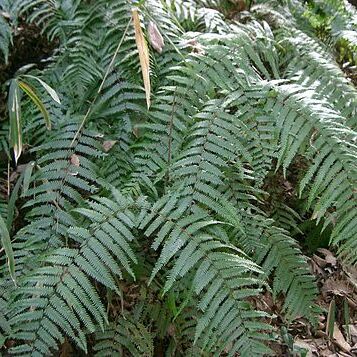Plants terrestrial, often forming thickets. Rhizomes long creeping, protostelic, with scales or multicellular hairs. Fronds monomorphic, evergreen, erect, scrambling, or climbing, vernation circinate; stipe not articulate, distant, cylindrical, apex forked, with dormant bud; apical bud covered with hairs or scales; rachis simple to several times pseudodichotomously branched [or pinnate], with stellate hairs and/or ciliate scales when young, these persistent or glabrescent; pinnules pectinately pinnatisect; lobes elliptic or lanceolate, apex obtuse or acute; veins free, forked; lamina papery or subleathery, frequently glaucous abaxially. Sori in 1(-3) lines on both sides of lobe costules, orbicular, exindusiate; sporangia 2-10[-16], sessile, turbinate, with a mid-transverse annulus; spores tetrahedral or reniform, without perispore, smooth.
Terrestrial homosporous ferns. Rhizome slender, protostelic, rarely solenostelic in Dicranopteris (not in Australia), bearing scales or hairs. Fronds erect, scrambling or climbing; lamina pseudodichotomously branched, once or more pinnate, of indeterminate growth due to presence of dormant buds in branch axils (absent in Gleichenia abscida ); segments adnate; veins free; vernation circinnate. Sori round or nearly so, exindusiate, consisting of a small number of large sporangia with an oblique or nearly apical annulus. Spores without chlorophyll. Gametophyte long-lived, elongate to subcordate.
Perennial terrestrial herbs with wide–creeping rhizomes; frond apparently dichotomous, due to arrested growth owing to the formation of a dormant terminal bud; apex of rhizome and buds covered with scales or hairs; stipule–like leaflets present in some species; pinnae lobed almost to the costa, elongate (in W.African species), with forked free veins; sori on the veins punctate with a few large subsessile sporangia; no indusium; annulus uniseriate, sharply defined, oblique and complete except at the line of dehiscence; dehiscence vertical; spore trilete (in W.African species)
Terrestrial herbs, often large, with widely creeping rhizomes bearing scales and/or hairs

